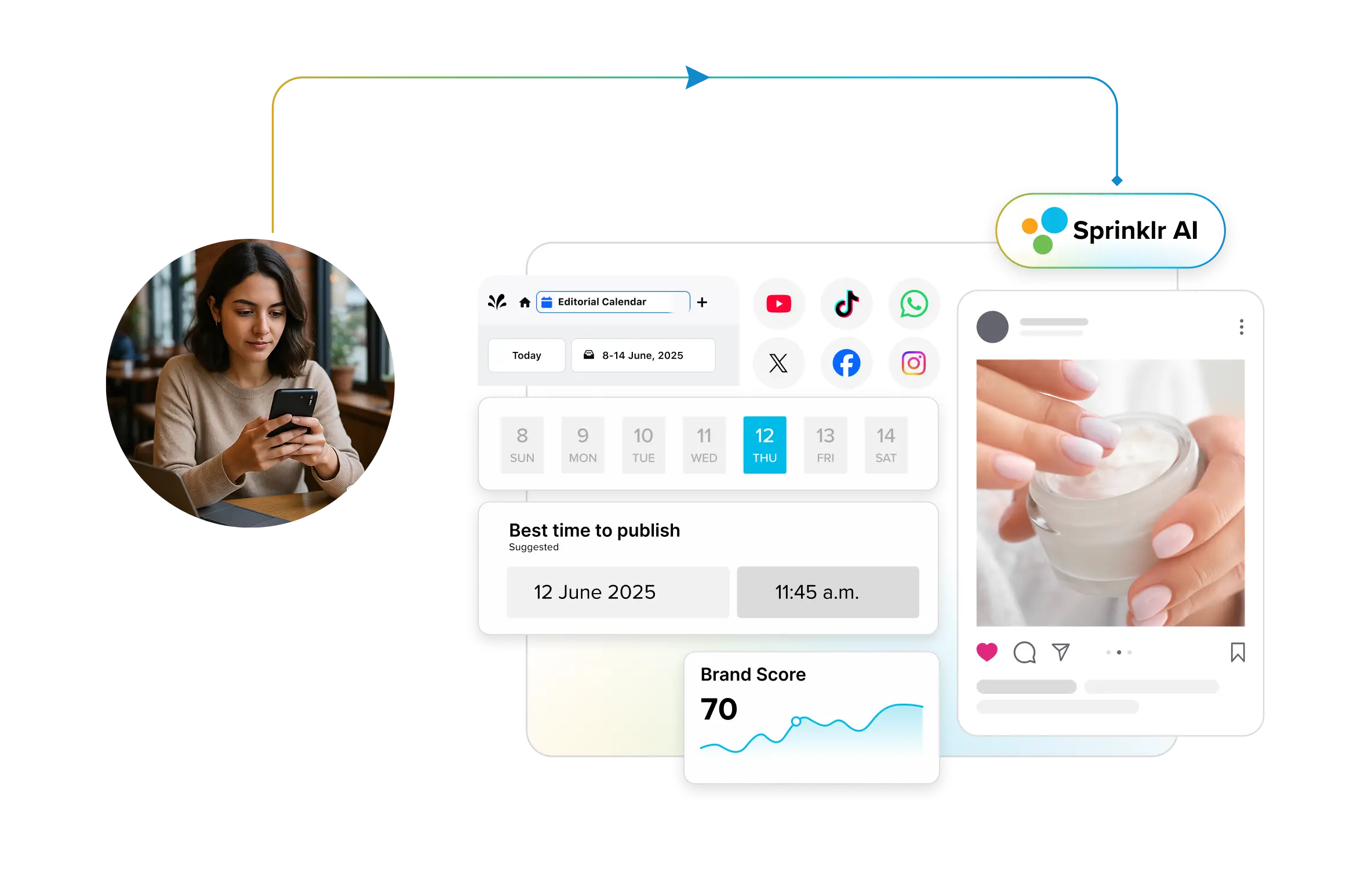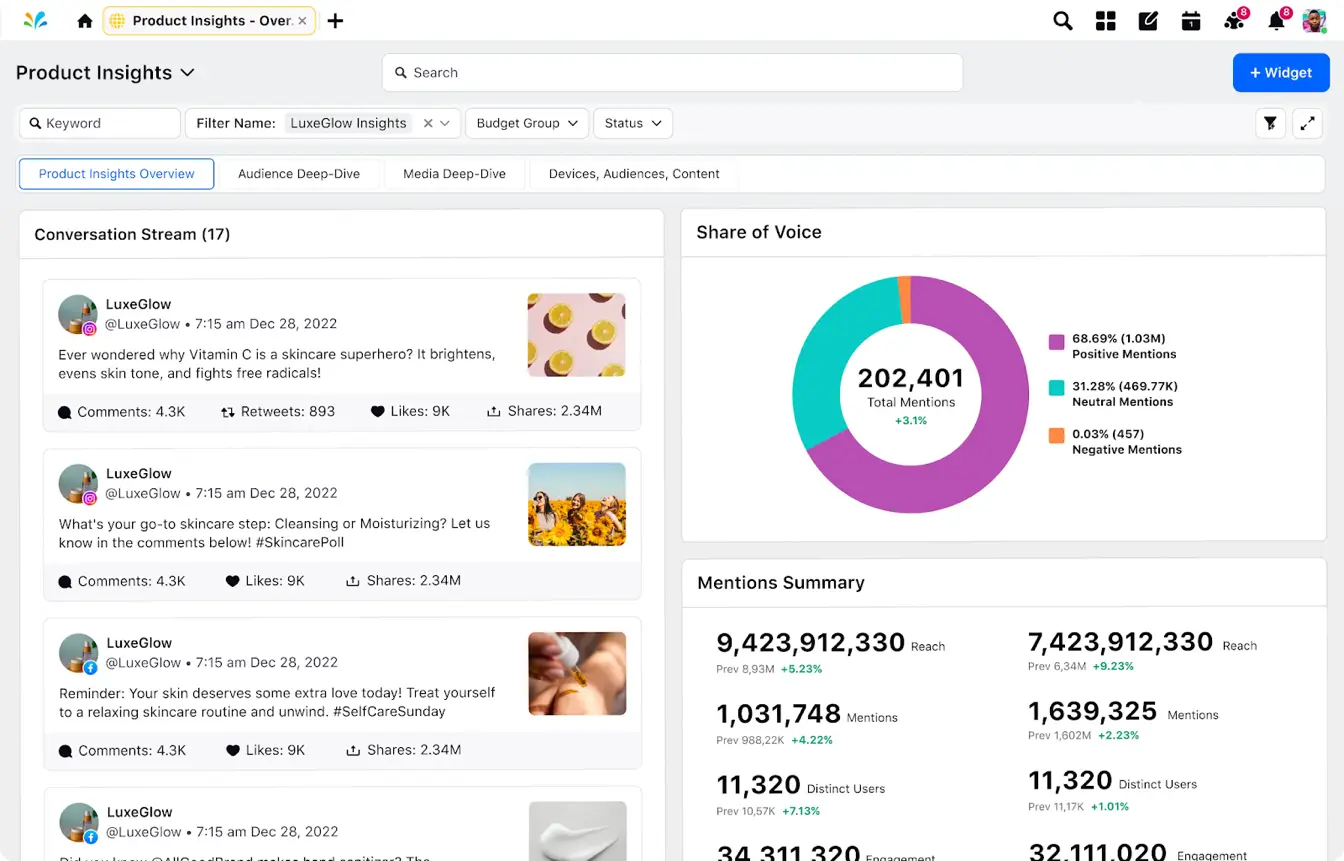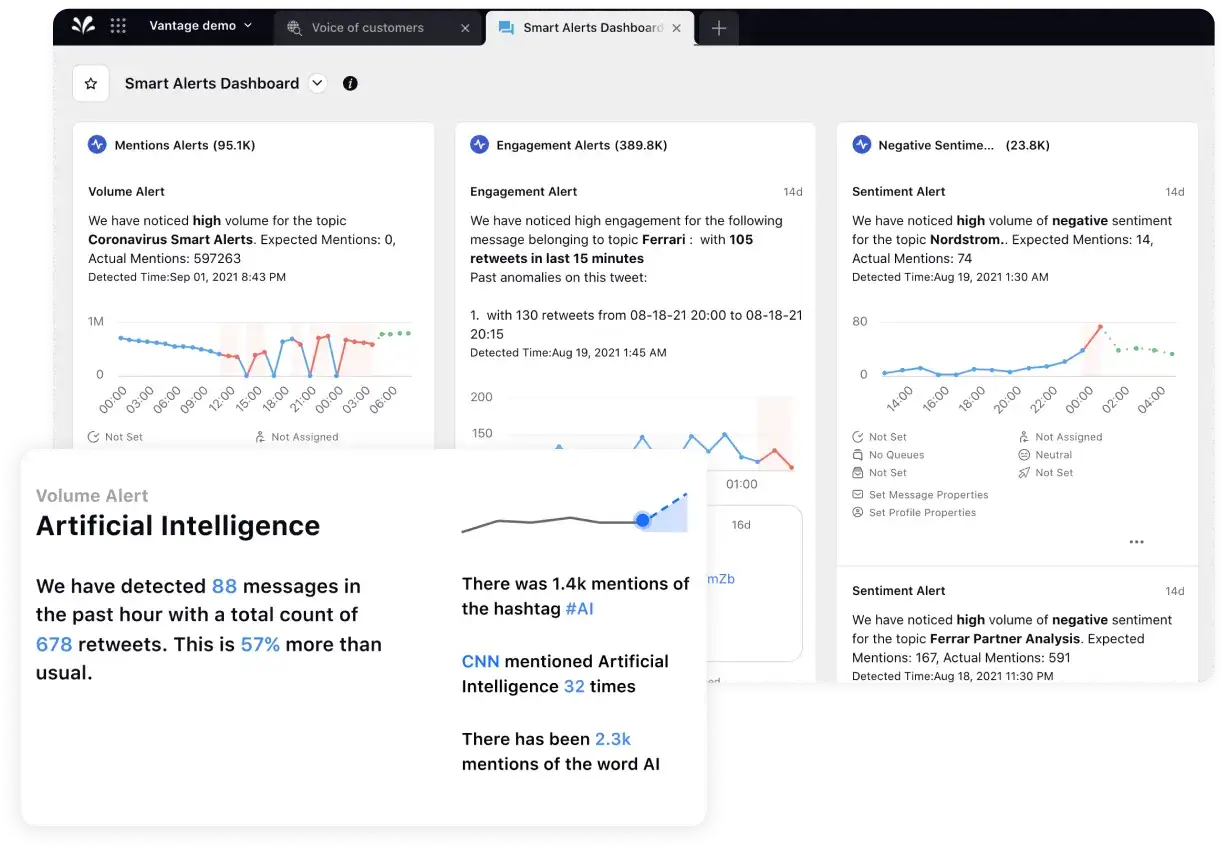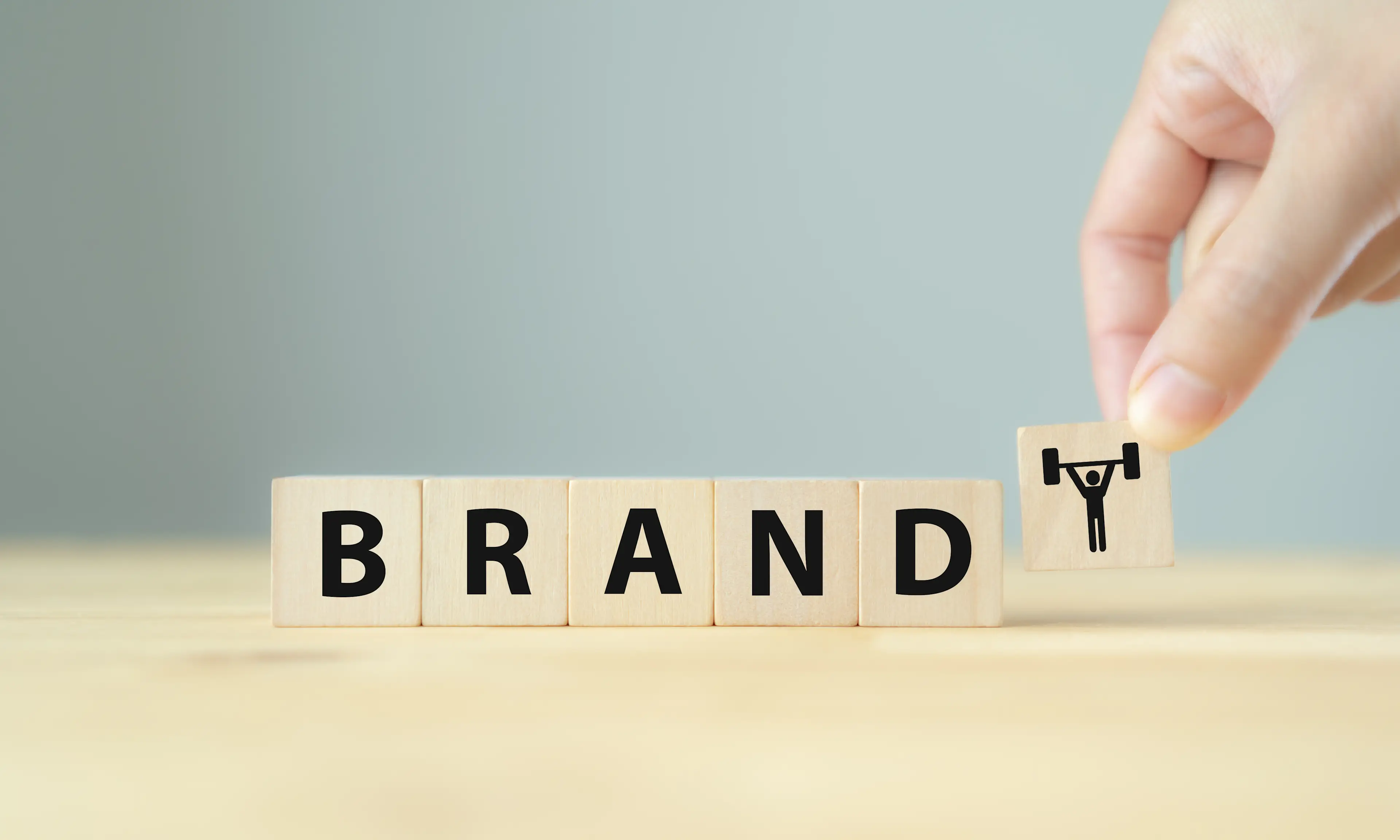The global leader in enterprise social media management
For over a decade, Sprinklr Social has helped the world’s biggest brands reimagine social media as a growth driver with a unified platform, industry-leading AI and enterprise-grade scale.

Brand Recognition: Meaning, Metrics & Tips
When you see a half-bitten apple or hear the Netflix “ta-dum,” you don’t need the brand name spelled out; you already know it. That’s the essence of brand recognition: the ability of people to identify a brand instantly through its visual or auditory signals.
Strong brand recognition doesn’t just make a brand memorable. It builds trust and credibility even before a purchase decision is made. 81% of customers are more likely to buy from brands they trust, and trust often starts with familiarity.
In this post, we’ll break down what brand recognition really means, how it differs from brand awareness and brand recall, what fuels it, the metrics that prove it’s working and tips you can use to strengthen your brand’s visibility.
What is brand recognition?
Brand recognition refers to how easily consumers can identify your brand when they encounter visual or auditory cues, such as logos, packaging, brand colors, taglines or even sounds. Strong recognition makes your brand stand out instantly, even in crowded digital spaces.
For example, Mastercard dropped its name from its logo, relying solely on the two overlapping red and yellow circles for the recognition.
Their research showed over 80% of consumers could still identify the brand, proving strong recognition doesn’t need words. Quick visual cues like Mastercard’s circles create instant connection, which is especially effective across fast-moving feeds and digital channels.
Is brand recognition the same as brand recall and brand awareness?
Not exactly. These concepts are closely related but serve different functions in brand strategy:
Brand recognition is the ability to identify a brand when presented with a visual or auditory cue — like hearing the Netflix intro or seeing Mastercard’s overlapping circles.
Brand recall means remembering the brand without any prompt. For example, if asked to name a CRM platform, and you answer “Salesforce,” that’s recall.
Brand awareness is the broader concept that includes both recognition and recall. It reflects how familiar your audience is with your brand overall.
Factors that drive strong brand recognition
Brand recognition doesn’t come from a single logo or tagline. It builds when your brand shows up consistently and meaningfully across every touchpoint.
Key drivers include:
- Visual consistency: Using the same colors, fonts and design style across platforms
- Unified brand voice: Keeping tone and messaging aligned across social, ads and customer service
- Strong share of voice: Ensuring visibility in social media, paid ads, PR and SEO
- Advocacy: Leveraging employees, influencers and loyal users to spread the brand identity
- Emotional and ethical alignment: Standing for values that resonate with audiences and reinforcing them consistently
Understanding what brand recognition is sets the foundation, but the bigger question is why it matters.
Freebie Alert: Give Your Brand One Voice on Social Media
Disjointed messaging across platforms can dilute your brand. This guide helps you define a consistent voice, tone, and visual style — so every team speaks with clarity and cohesion.
Learn why brand guidelines matter, what to include, and how to build your own in seven clear steps.
Also Read: What Makes a Brand Community Successful
Why does brand recognition matter for businesses?
Recognition directly influences how customers choose, trust, and remain loyal to a brand. Familiar brands build trust more quickly, making their ads feel relevant rather than intrusive. This familiarity reduces friction in the buying process and lowers customer acquisition costs (CAC).
Strong recognition also improves visibility in AI-generated answers, which now play a growing role in B2B and B2C buying journeys. Being surfaced in these results reduces due diligence time, lowers perceived procurement risk and positions your brand as the credible option on competitive shortlists. The impact is faster deal cycles and higher win rates.
In crowded markets, brand recognition often tips the scales. Two products may have similar features, but the one that customers recognize feels safer, more reliable, and more valuable.
The impact is clear:
- 5 in 10 consumers said they would pay more if a brand’s image appealed to them, showing how recognition influences pricing power.
- In 2024, Statista reported that the top 100 brands were valued at $8.3 trillion, up from $5 trillion just four years earlier, proving how recognition drives long-term market value.
- The Amazon Ads Higher Impact study found that 79% of consumers prefer brands whose values align with theirs, highlighting how recognition today is tied to identity as much as visibility
How long should I run a brand recognition study before acting on the results?
Aim for 3-6 months to capture reliable trend data. Acting too early risks misreading short-term spikes as meaningful shifts, leading to wasted budgets, premature creative pivots or abandoned campaigns. A longer study period ensures you see how recognition holds up across campaigns, seasons and competitive activity, giving you a true picture of lasting brand impact.
Read More: What is Employer Branding? Meaning, Methods and Tips
How to measure brand recognition
Unlike surface-level numbers, measuring brand recognition requires looking at how often and how easily people identify your brand in real-world contexts.
Here are proven brand recognition best practices to track it:
1. Use surveys and brand recognition studies
Brand surveys are the most direct way to understand recognition. They typically include two types:
Aided recall | Unaided recall |
You give respondents a prompt, such as showing a logo or tagline, and ask if they recognize it. For example, “Which of the following logos do you recognize?” | You ask respondents to name brands without hints. For example, “When you think of running shoes, which brands come to mind?” |
Benefits of aided and unaided recall:
- Surface-level recognition and deeper memory associations
- How quickly a brand comes to mind in buying situations
- The strength of mental availability against competitors
- Gaps between awareness and preference that can guide brand recognition strategies
Suggested action:
Use survey insights to refine both creative and media strategies.
For example, if aided recall is high but unaided recall is low, your brand may need more distinctive cues (slogans, colors, brand assets) that stick in memory. If unaided recall is strong but preference is weak, prioritize messaging that reinforces differentiation and trust to move recognition into consideration and choice.
2. Track branded search volume
Branded search traffic shows how often people actively look for your company by name.
For instance, if searches for campaign hashtags spike after a campaign, it means people are connecting the brand name to the product. Rising branded searches also signal stronger recognition and interest, not just general category demand.
Benefits:
- Captures the direct intent of the target audience
- Shows if your brand is top-of-mind over competitors
- Indicates recognition beyond the generic category demand
Suggested action:
Use SEO platforms, competitive benchmarking tools, and advanced analytics dashboards to track branded search volume over time. This metric serves as a proxy for efficiency.
Rising branded searches often reduce reliance on paid media for traffic acquisition, lowering cost-per-acquisition (CPA). A stronger share of branded searches can also correlate with higher conversion rates, since visitors already trust the brand.
Benchmarking branded search volume against competitors lets you measure brand equity as a performance KPI, connecting marketing spend directly to long-term ROI and customer lifetime value.
Pro tip: Don’t just track branded search volume in isolation. Map it against campaign spend and conversion metrics. If branded searches rise while cost-per-acquisition drops, it’s a clear signal that brand equity is compounding and reducing reliance on paid acquisition.
You can also use tools like Sprinklr Listening and Sprinklr Competitive Benchmarking to track branded search mentions alongside sentiment and competitive context. These can:
- Show how your branded search compares with competitors over time.
- Identify spikes in brand interest tied to campaigns or events.
- Surface regional and demographic insights behind branded search trends.
- Connect branded search performance with broader brand health metrics.

3. Monitor social media mentions and visual recognition
Social platforms are where brand signals like names, hashtags, logos and even packaging circulate the fastest. Tracking how often your brand appears in conversations or user-generated content gives you a direct pulse on visibility and perception.
Unlike traditional surveys, this real-time view reflects how people actually engage with your brand in everyday contexts.
Benefits:
- Uncovers authentic, unfiltered conversations around your brand
- Highlights the impact of visual identity (logos, packaging, product shots) on recognition
- Measures visibility against competitors to spot market positioning gaps
- Links recognition to sentiment shifts, helping you manage reputation proactively
Suggested action: Rely on modern social media management tools that can track not just brand mentions but also visual cues such as logos or packaging showing up in user-generated content.
Key metrics include:
- Hashtag mentions: How often branded or campaign hashtags appear
- Logo/visual detection: How frequently your logo shows up in shared images or videos
- Sentiment analysis: Whether the customer sentiments are positive, negative, or neutral
- Share of voice: Your brand’s visibility compared to competitors in the same space
Real-time social tracking ensures you see both exposure and perception shifts as they happen.
What’s the most efficient way to grow brand recognition on a platform you’re just entering?
Start with consistent visuals and frequent posting. Then amplify reach using micro-influencers already active on that platform. This combination builds familiarity faster and positions your brand as native to the space, rather than an outsider trying to break in.
Know More: How to Improve Your Brand's NPS
4. Analyze website and referral traffic patterns
Direct traffic (users typing your URL directly) and branded referral traffic (clicks from branded mentions elsewhere) indicate recognition at work. Tools that offer analytical and reporting can show:
- How much traffic comes from direct brand searches
- Which referral sites or articles mention and drive traffic to your brand
- Trends over time (steady increases show recognition growth)
Pro Tip: Measuring brand recognition against competitors helps you spot risks before they impact revenue. Here's how to do it efficiently:
- Start with branded search volume to see who’s capturing early-stage buyer interest
- Analyze direct traffic share to understand loyalty and acquisition efficiency.
- Review referral visibility to identify who’s influencing perception across external platforms.
Use Sprinklr’s Analytical and Reporting tools to track these metrics in one view. With real-time insights, you can adjust budgets, close competitive gaps, and protect brand equity before it slips.

Together, these brand recognition metrics give a complete view of visibility, sentiment, and audience memory.
Common mistakes that weaken brand recognition
Even established brands can dilute their recognition by falling into these traps:
- Inconsistent visuals or tone across channels: Using different logos, color variations, or messaging styles creates confusion instead of clarity
- Overcomplicating your brand identity: Adding too many taglines, design elements, or campaign themes makes it harder for consumers to lock onto what your brand stands for
- Neglecting your offline or packaging presence: Recognition isn’t built online alone; weak in-store displays or forgettable packaging reduce recall at the purchase moment
- Focusing too much on short-term metrics: Optimizing purely for clicks or sales can miss the bigger picture: building memory structures that pay off long-term
How do crisis moments affect brand recognition over time: positively or negatively?
Crises amplify recognition, sometimes for good (if handled transparently) and sometimes for harm (if mishandled). The long-term impact depends on how quickly and authentically your brand responds and manages a crisis.
5 actionable tips to build brand recognition
Now that we’ve covered the basics of brand recognition, the next step is execution. These five strategies focus on what both practitioners and leaders can do to strengthen recognition through consistent, scalable, and measurable actions.
1. Stay consistent with brand visuals and messaging
Logos, colors, typography and tone of voice form the core of your brand. If these elements shift across channels, recognition weakens.
A consistent presence builds familiarity and ensures people instantly connect signals (like a logo or phrase) back to your brand.
Suggested action for practitioners:
- Develop a brand style guide that covers logos, fonts, colors and voice, then share it across all internal and external teams
- Audit your website, packaging and digital campaigns for consistency
- Use tools like Canva Brand Kit or Adobe Libraries to keep assets uniform
Suggested action for decision makers:
- Set brand governance policies that require adherence to the style guide across regions and business units
- Invest in digital asset management (DAM) systems to maintain control at scale
- Track brand compliance metrics to ensure external agencies and partners follow brand rules
2. Use repetition across high-traffic channels
Brand recognition grows when people encounter your brand repeatedly across the platforms they use most, such as social media, ads, product packaging or even something subtle like email signatures.
Frequency strengthens familiarity and ensures your brand becomes top-of-mind in buying situations.
Suggested action for practitioners:
- Add your logo and tagline consistently across email footers, invoices and packaging
- Run campaigns across multiple high-traffic channels (e.g., Instagram + YouTube + display ads) to reinforce visibility
- Use tools like Google Ads frequency capping or Sprinklr’s AI-driven publishing to balance repetition without overwhelming your audience
Suggested action for decision makers:
- Allocate budget to omnichannel campaigns that reach customers across their preferred touchpoints
- Benchmark brand exposure against competitors using share-of-voice and reach metrics
- Link campaign repetition to downstream KPIs like incremental revenue and lower CAC
3. Partner with influencers or brand advocates
Consumers are more likely to remember and trust a brand when it’s recommended by someone they follow or admire.
Influencers and brand advocates lend credibility, embedding your brand into conversations and making it feel more relatable than paid ads alone.
Suggested action for practitioners:
- Track impact by monitoring branded hashtag use, follower growth, or referral traffic from influencer content
- Use affiliate links or discount codes unique to each influencer to measure direct conversions and ROI
- Analyze engagement quality on influencer posts (comments, saves, shares)
- Run sentiment analysis on influencer mentions to capture tone and audience response
- Segment performance by influencer tier (nano, micro, macro)
Suggested action for decision makers:
- Define governance models for influencer selection (compliance, values alignment, audience overlap)
- Assess ROI by linking influencer-driven recognition to incremental sales or earned media value
- Empower employees as advocates using an employee advocacy platform. Equip teams with easy access to curated, shareable content so they can extend your brand’s reach organically
- Create programs to encourage your customers to become your advocates
For example, Lenovo scaled employee advocacy by integrating Sprinklr Advocacy into its global social strategy. The goal was to give employees an easy, compliant way to share meaningful brand content — from product launches and innovation milestones to personal stories and values they care about. With tailored training and easy-to-share content, Lenovo enabled employees across regions and roles to become trusted brand voices on social media.
In just six months, Lenovo activated more than 2,350 employee advocates, resulting in a 360% increase in social media reach and a 200% boost in engagement. With Sprinklr, the company turned internal advocacy into a measurable driver of brand awareness, credibility, and marketing efficiency at scale.
Know More: How To Turn Your Customers Into A Community Of Brand Advocates
4. Invest in experiential or emotional branding
Brand recognition is strongest when it’s tied to emotions or experiences. Storytelling, immersive events, or aligning with meaningful causes help brands become memorable beyond their products.
Suggested action for practitioners:
- Host experiential pop-ups or virtual events that showcase your brand’s personality
- Collaborate with creative agencies to build sensory experiences tied to your brand story
- Support causes that align with your brand values (e.g., sustainability, education, community)
Suggested action for decision makers:
- Allocate budget for immersive storytelling campaigns that drive long-term memory rather than short-term clicks
- Link cause-driven campaigns to brand equity metrics (brand lift, preference scores, NPS)
- Measure ROI of experiences not just in sales but in earned media coverage, customer advocacy, and retention
Example 1:
Patagonia: Its bold “Don’t Buy This Jacket” campaign challenged overconsumption and positioned the brand as an environmental guardian.
The impact was twofold: sales grew, and Patagonia embedded itself in customers’ minds as the gear brand with a conscience.
The takeaway: aligning with a cause your audience cares about makes your brand unforgettable.
Example 2:
IKEA: With immersive stunts like the “Real Life Series,” where they recreated iconic TV living rooms using IKEA furniture, the brand tapped nostalgia while showcasing practicality.
The impact was viral cultural relevance paired with direct product visibility. Storytelling through experiences makes your brand part of people’s everyday conversations.
5. Leverage customer-generated content
When customers create and share content featuring your brand, such as photos, reviews, unboxings or case studies, it serves as social proof and increases visibility.
UGC not only strengthens recognition but also builds credibility, since people trust peers more than polished ads.
Suggested action for practitioners:
- Encourage customers to post using branded hashtags or contests
- Showcase UGC on your website, product pages, or social media feeds
- Use engagement tools to track UGC mentions and amplify high-performing content
Suggested action for decision makers:
- Build UGC into brand governance strategy, ensuring usage rights and legal compliance
- Measure the impact of UGC on trust metrics and conversion rates
- Allocate budget to UGC amplification as a cost-efficient alternative to paid media
How do you isolate brand recognition data by region without misreading noise vs. signal?
Compare regional trends against a baseline (like national or global averages) and focus only on sustained, not one-time spikes.
How you can improve brand recognition with Sprinklr
Sprinklr Social helps enterprises overcome common brand recognition challenges by unifying social media management across multiple brands, teams, and geographies. Its broad channel coverage supports 30+ platforms, ensuring you never miss a customer interaction or cultural moment that could amplify your brand.
Key capabilities include:
- Comprehensive Social Listening: Sprinklr’s listening monitors millions of data sources, capturing brand mentions, hashtags, and conversations not only on social channels but across the wider web. This enables teams to track how the brand appears in real time and engage proactively.
- AI-Driven Insights and Visual Recognition: Sprinklr’s best-in-class AI analyzes sentiment and competitive benchmarks, while image detection unlocks insights from visual content like logos and product images. These insights help refine messaging strategies that resonate deeply with your audiences.
- Enterprise-Grade Governance and Unified Publishing: With customizable approval workflows and moderation rules, Sprinklr ensures consistent brand voice and visuals across all channels. Centralized publishing tools empower distributed teams to deliver coordinated campaigns and responses efficiently.
- Integration with Unified-CXM: By connecting social media management with broader customer experience functions such as marketing, advertising, and service, Sprinklr makes brand recognition a holistic enterprise capability rather than a fragmented effort.
Sprinklr Success Story: PDS Health, a healthcare support organization with over 1,000 offices across 24 states, transformed its social media management by adopting Sprinklr Social and Insights.
The platform helped PDS unify content distribution, automate review responses, and harness real-time voice of customer data to maintain consistent messaging and engage effectively with patients nationwide. This shift streamlined operations, improved brand cohesion, and enabled data-driven decision-making across its expansive network.
Final thoughts
Brand recognition is the foundation of customer trust—it’s what makes people choose, buy, and recommend without hesitation. Strong recognition lowers costs, boosts conversions, and builds lasting loyalty. It also influences key moments like AI-driven recommendations and share of voice.
Sprinklr makes brand recognition measurable and manageable. It unifies your messaging and visuals across all channels, tracks every mention online, and uses AI to refine how your brand connects with audiences.
Discover how Sprinklr Social can elevate your brand’s presence and accelerate growth.
Frequently Asked Questions
Brand recognition means identifying a brand when shown a cue (logo, color, sound). Brand recall means naming the brand unprompted.
Typically, 6–12 months of consistent exposure is needed to see measurable growth, depending on industry and competition.
Brand recognition best practices include staying visually consistent, using tools like Sprinklr Social to track branded searches, leveraging user-generated content and collaborating with micro-influencers who fit your audience.
Yes. In B2B, recognition builds trust and reduces perceived risk. A familiar brand is more likely to make it to shortlists during vendor evaluations.
Sprinklr helps monitor, measure and amplify recognition. It can unify brand messaging across channels, tracking visual and textual mentions globally. You can also use AI insights to strengthen audience alignment and upliftment of brand recognition metrics.










